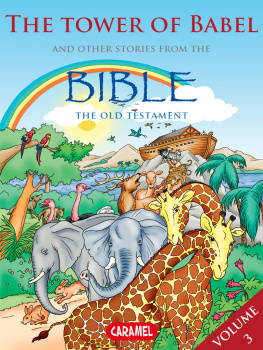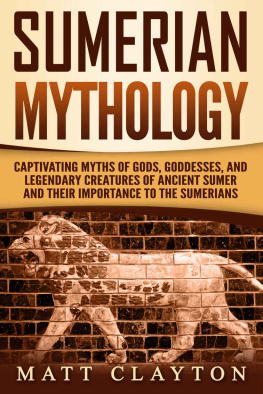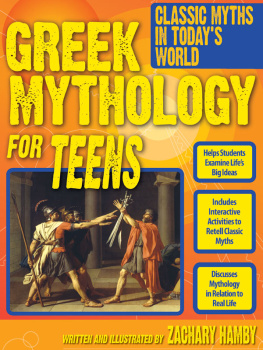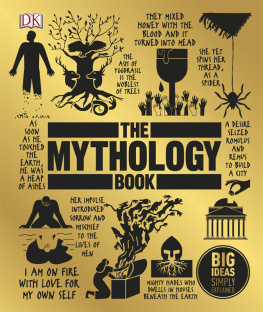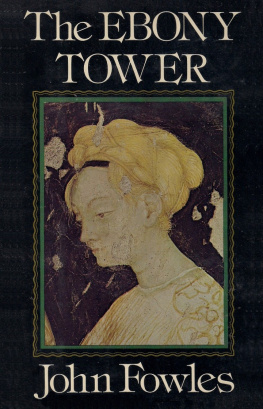Table of Contents
Table of Figures
Tell me your myth that the whole world may turn to myth.
Nikos Kazantzakis, The Odyssey: A Modern Sequel
[Translated by Kimon Friar (New York: Simon and Schuster,
1958), Book XXI, 1.1277.]
FOREWORD
While I was reading The Seven Story Tower in manuscript, I tried to describe its unusual quality to a friend, who remarked, It sounds more like an experience than a book. I agreed, but then felt even more acutely the difficulty of introducing this beguiling and involving book. Its form and content are particularly inextricable.
The author takes his title from the image of a tower in which the ascending person sees views of increasing complexity and significance through the windows.
But I was looking for a supplementary overall metaphorsomething organic, lush, proliferating, bizarre, but not ultimately chaotic. I had in mind Hoffmans remark that we resist letting myth impact our lives seriously, because this archetypal domain is threatening. Here, those hidden fears surface which we would rather not acknowledge, let alone confrontor befriend.
Ive settled for the rather unoriginal comparison of the reader as traveler. He sets forth, rather vague as to his goal, on a trek through a territory perhaps larger and more strange than he had expected. Part jungle, part cultivated, it plunges him into beauty and horror, danger and delight.
Fortunately, the apprehensive tourist has Hoffman at hand as a tranquil, observant interpreter. At each stage of the journey (seven key tales forming the basic structure of the book) the author has the situation well in hand. Harking back to the experiences just past, he explains, supplements, enriches, compares, connects, reassures, hints, and warns. Looping forward in time, he prepares us for what lies ahead and connects it to what has occurred.
Hey, Im beginning to get it! says the traveler. For the result of this complicated interweaving is that somehow the contours of the country begin to emerge. Though perhaps they will always be somewhat shifty, moveable, evasive.
More important, the voyager begins to perceive that though the goal may never be clearly definedthough the central mystery may remain forever more or less obscurethe journey is not only worthwhile, but essential. Thus the traveler is encouraged and equipped to proceed, though perhaps hoping he may not have to cope with still another boar-tusked lady or a severed head talking as it rolls.
Looming against the sky line are three vast stone shapes, like well-meaning Easter Island statues: Campbell, Lvi-Strauss, and Jung. They have done their best to map the territory. And here perhaps is a good time to shrink the stone shapes down to human-scholar size and to attempt a more prosaic summing up.
In generously acknowledging the influence of these writers and many others, Hoffman never accepts any one point of view uncritically. Nor does he indulge in dogmatic condemnations. Everyone who has approached mythology may have a piece of the truth. Gentleness and respect are essential, and the doors must be left open for further research, speculation, and insight.
The seven key stories give the reader a sense of structure, yet of flowing movement in space and time. The last of them is a modern one and of special interest in helping us to understand the whole. This tale comes from the mythology created by J.R.R. Tolkien, author of The Lord of the Rings. Hoffmans analytic and synthetic approach to the first six stories equip the reader to understand and evaluate his claim that in Tolkiens work we have a real secondary world, a valid myth.
Myth, as Campbell says, forms the interface between what can and cannot be expressed. Its a marvelous territory for exploration.
Bon voyage!
Edith Gilmore, Ph.D.
PREFACE
The Seven Story Tower is an introduction to the fascinating world of myth, explored in cross-cultural context. It is designed to provide the reader with the conceptual tools essential for the analysis and appreciation of myth as a vital function of human cultural expression. I approach the subject of myth from a social sciences perspective, combining the insights of cultural anthropology and analytical psychology. On one level, the purpose of the book is to guide the reader in the use of both analytical and synthetic methods: analytical, because each myth is considered within its specific cultural context; synthetic, because by comparing myths from different cultures around the world it becomes possible to formulate general conclusions about the role of myth in human society, including our own. On another level, its multilayered stories work to stimulate the readers emotional appreciation of myths power today over our lives and societies. Each chapter introduces specific structures that occur within myths: transformation, inversion, substitution and recombination, aetiology, family structure, and ethical dualism. Other themes of importance are explored, such as the significance of names and numbers; relationships to cultural ideas about the plants, animals, and heavenly bodies, as well as the structure of the human body; social tensions between church and state, men and women, old and young, culture and nature; and especially the process of individual maturation in a social context. The latter theme is expected to be of particular appeal to younger readers, who are undergoing the same inevitable social consequences of assuming adult responsibility in a complex world which are central to so many of the myths in this book.
In his brilliant, but nearly forgotten novel A Voyage to Arcturus, David Lindsay depicts a tower comprised of seven stories, each with an embrasure window through which a climber can look out upon the world. Lindsay, who died young, was a member of the Inklings, a circle of British fantasy writers which included J.R.R. Tolkien, C.S. Lewis, and Charles Williams. His protagonist Maskulls dark double, Nightspore, is directed to ascend the spiral staircase within the tower. At each stage, the view becomes more distant and abstract, but also more philosophically profound, until Nightspore reaches the summit of the tower and realizes that the responsibility for the fate of the imperiled world lies, at least partially, in his hands. This powerful image came to mind once I realized that the number of key myths in this exploratory venture would be seven, and I knew at once what the title of the book must be. For I also offer the reader seven views upon the world, through mythic windows, which I have chosen because they display great diversity through space and time, yet have a remarkable thematic similarity. These represent the Irish, Greek, Sumerian, Indonesian, Amazonian, and Inuit cultures, and the fantasy world of J.R.R. Tolkien. By the time the seventh stage is reached, I hope it will be clear that there is indeed an inevitable linkage between myth and social responsibility.
A few words of introduction about my approach to myth are in order. I am an archaeologist by profession, and my academic training was in the archaeology of the Near East, especially of Mesopotamia. For most of the past twenty-five years, however, I have concentrated on the pre-European cultures of my home region, northeastern North America. This is a region in which the environment and its early inhabitants conspired to leave behind only scant traces of human activity, mostly in the form of stone tools. These Native peoples never developed a system of written communication, and the Europeans who arrived here in the seventeenth century were rather effective in eliminating nearly all overt traces of the Native belief system, which they viewed as inferior to their Puritan brand of Christianity. Some of the Native myths and practices have survived, but after 350 years of political and religious persecution many of the people have become so assimilated that they have forgotten the larger cultural system to which the stories once belonged, and they are understandably reluctant to share with outsiders what they do retain. Thus, most of my work has been a study of a culture whose myths are almost irretrievable.


